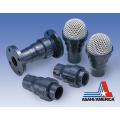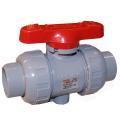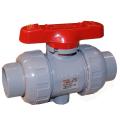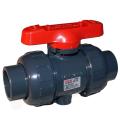Products


Asahi/America Duo-Bloc® Type 21 thermoplastic ball valves provide a dependable and economical way to handle corrosive chemicals. They perform at temperatures up to 250°F, and pressures to 230 psi (150 psi for polypropylene valves). True Union Duo-Bloc® Type 21 Ball Valves can be lifted from the line, simply by loosening the two union nuts. The valve can be disassembled, and parts may be replaced. The Duo-Bloc® feature blocks in two directions, leaving full pressure opposite, and allowing disconnection of downstream piping.

Asahi/America Duo-Bloc® Type 21 thermoplastic ball valves provide a dependable and economical way to handle corrosive chemicals. They perform at temperatures up to 250°F, and pressures to 230 psi (150 psi for polypropylene valves). True Union Duo-Bloc® Type 21 Ball Valves can be lifted from the line, simply by loosening the two union nuts. The valve can be disassembled, and parts may be replaced. The Duo-Bloc® feature blocks in two directions, leaving full pressure opposite, and allowing disconnection of downstream piping.

Asahi/America Duo-Bloc® Type 21 thermoplastic ball valves provide a dependable and economical way to handle corrosive chemicals. They perform at temperatures up to 250°F, and pressures to 230 psi (150 psi for polypropylene valves). True Union Duo-Bloc® Type 21 Ball Valves can be lifted from the line, simply by loosening the two union nuts. The valve can be disassembled, and parts may be replaced. The Duo-Bloc® feature blocks in two directions, leaving full pressure opposite, and allowing disconnection of downstream piping.

Asahi/America Duo-Bloc® Type 21 thermoplastic ball valves provide a dependable and economical way to handle corrosive chemicals. They perform at temperatures up to 250°F, and pressures to 230 psi (150 psi for polypropylene valves). True Union Duo-Bloc® Type 21 Ball Valves can be lifted from the line, simply by loosening the two union nuts. The valve can be disassembled, and parts may be replaced. The Duo-Bloc® feature blocks in two directions, leaving full pressure opposite, and allowing disconnection of downstream piping.
